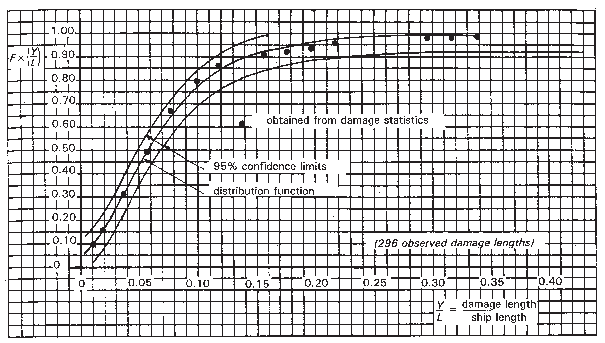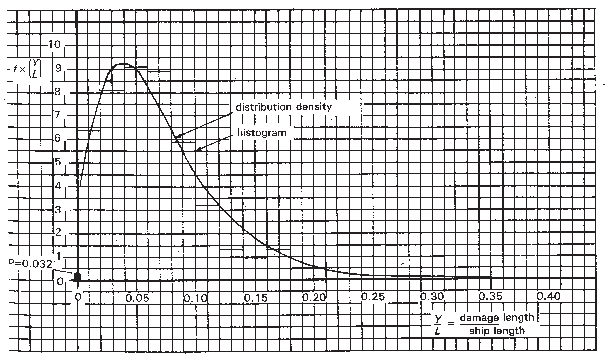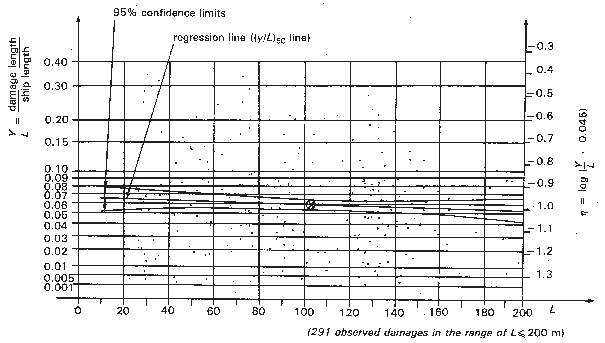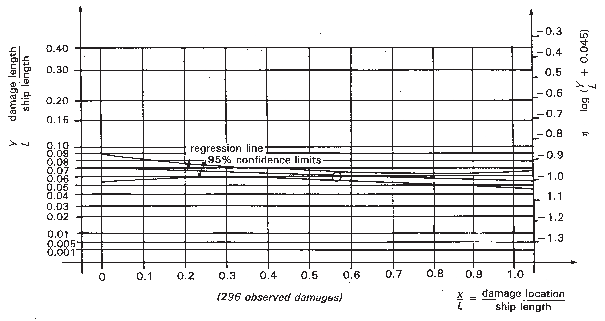Preliminary investigations have led to the conclusion that
the distribution of the ratio damage length to ship length y/L is more or less independent of the ship length. A proof will
be given below. As a consequence, y/L can
be taken as independent of L.
From theoretical considerations (using the central limit
theorem) it follows that  (where ∊y is constant) is approximately
log-normally distributed. This is confirmed by Figures 7 and 8, in which good agreement is shown
between the log-normal distribution function and distribution density
on the one hand and the corresponding results of the damage statistics
on the other.
(where ∊y is constant) is approximately
log-normally distributed. This is confirmed by Figures 7 and 8, in which good agreement is shown
between the log-normal distribution function and distribution density
on the one hand and the corresponding results of the damage statistics
on the other.

Figure 7 Distribution function of non-dimensional damage length

Figure 8 Distribution density of non-dimensional damage length
Figure 9 shows the
regression of y/ L on L for L≤200 m (five damages relate to ships with L>200
m). The regression line has a small negative slope which proved to
be insignificant, and may be caused by samples taken at random. There
might be a small dependence of y/L on the
ship length, but it is so small that it cannot be derived from the
given sample. It is therefore certainly no significant error to assume y/L to be independent of ship size for L≤200
m.

Figure 9 Regression of non-dimensional damage length on ship length
An explanation of this independence might be that small
vessels are more likely to meet mainly small vessels and large vessels
are more likely to meet mainly large vessels. However, this reasoning
cannot be extended to very large vessels because of the small total
number of such ships. Because of the very few damage cases concerning
ships with L>200 m, nothing can be said about the damage
distribution of such ships. It seems reasonable to assume, as an approximation
for ships with L> 200 m, that the median of the damage
length is constant and equal to the median for L = 200
m. The latter equals 200 x (y/L)50 where
(y/L)50 is the median of the
non-dimensional damage length for ships with L = 200
m.
The regression of the non-dimensional damage length y/L on the non-dimensional damage location is given in Figure 10. This shows that there
is no significant difference between the damage distributions in the
forward and aft half of the ship, but simple geometric reasoning indicates
that the damage length at the ends of the ship - forward as well as
aft - is limited to smaller values than in the central part of the
ship. Therefore the log-normal distribution found for all values for y/L - independent of damage location - is the
marginal distribution. The corresponding conditional distribution
of y/L, on the condition that the damage
location is given, does not need to be considered as for the practical
application an approximation will be used, which allows establishment
of a very simple relationship between the conditional and marginal
damage length distribution.

Figure 10 Regression of non-dimensional damage length on non-dimensional damage
location